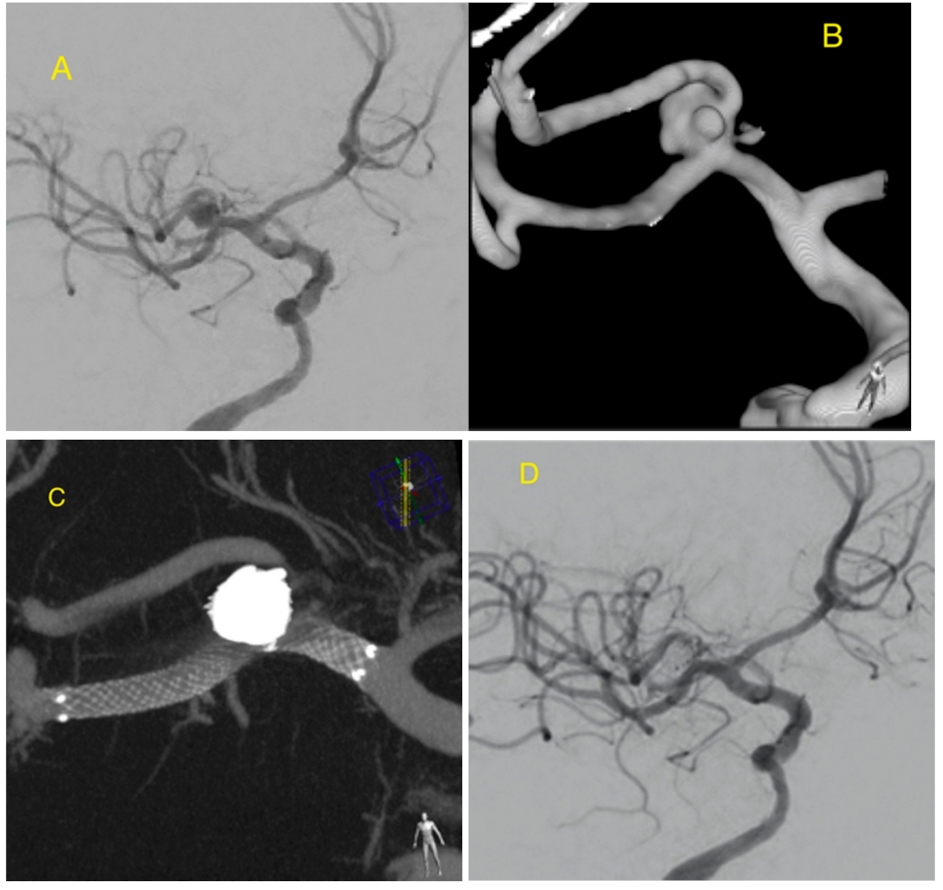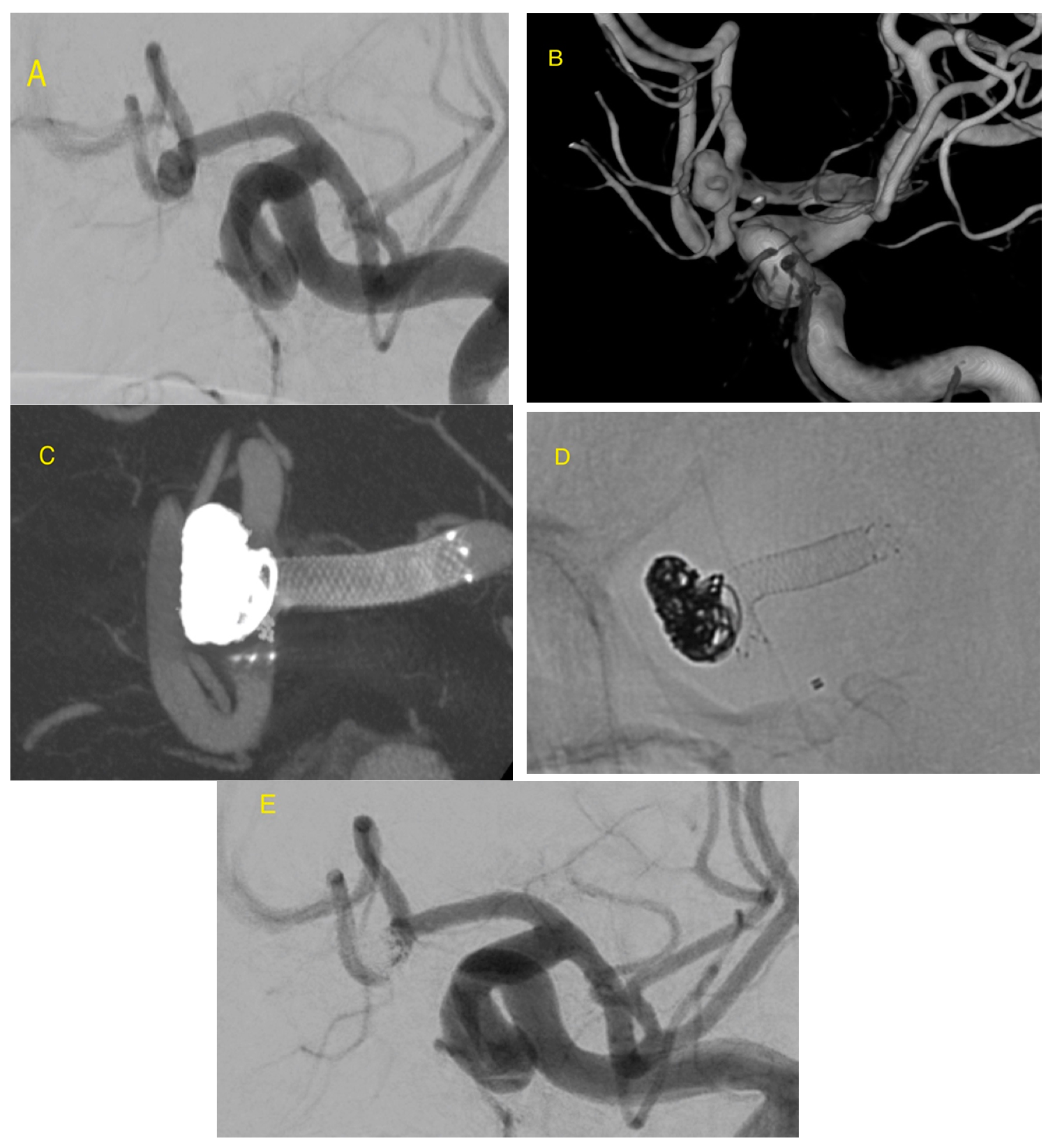Initial Experience with LVIS EVO Stents for the Treatment of Intracranial Aneurysms
Abstract
1. Introduction
2. Materials and Methods
3. Results
4. Discussion
5. Conclusions
Author Contributions
Funding
Conflicts of Interest
Abbreviations
| SAC | stent-assisted coiling |
| mRS | modified Rankin scale |
| DSA | digital subtraction angiography |
| AComA | anterior communicating artery |
| ACA | anterior cerebral artery |
| MCA | middle cerebral artery |
| ICA | internal carotid artery |
| BA | basilar artery |
| RROC | Raymond–Roy occlusion classification |
References
- Claiborne Johnston, S.; Wilson, C.B.; Halbach, V.V.; Higashida, R.T.; Dowd, C.F.; McDermott, M.W.; Gress, D.R. Endovascular and surgical treatment of unruptered cerebral aneurysms: Comparison of risks. Ann. Neurol. 2000, 48, 11–19. [Google Scholar] [CrossRef]
- Brinjikji, W.; Rabinstein, A.; Nasr, D.; Lanzino, G.; Kallmes, D.F.; Cloft, H.J. Better Outcomes with Treatment by Coiling Relative to Clipping of Unruptured Intracranial Aneurysms in the United States, 2001–2008. Am. J. Neuroradiol. 2011, 32, 1071–1075. [Google Scholar] [CrossRef] [PubMed]
- Molyneux, A.J.; Kerr, R.S.; Yu, L.M.; Clarke, M.; Sneade, M.; Yarnold, J.A. International Subarachnoid Aneurysm Trial (ISAT) Collaborative Group. International subarachnoid aneurysm trial (ISAT) of neurosurgical clipping versus endovascular coiling in 2143 patients with ruptured intracranial aneurysms: A randomised comparison of effects on survival, dependency, seizures, rebleeding, subgroups and aneurysms occlusion. Lancet 2005, 366, 806–817. [Google Scholar]
- White, P.M.; Wardlaw, J.M. Unruptured intracranial aneurysms. J. Neuroradiol. 2003, 30, 336–350. [Google Scholar]
- Phan, K.; Huo, Y.R.; Jia, F.; Phan, S.; Rao, P.J.; Mobbs, R.J.; Mortimer, A.M. Meta-analysis of stent-assisted coiling versus coiling-only for the treatment of intracranial aneurysms. J. Clin. Neurosci. 2016, 31, 15–22. [Google Scholar] [CrossRef] [PubMed]
- Poncyljusz, W.; Biliński, P.; Safranow, K.; Baron, J.; Zbroszczyk, M.; Jaworski, M.; Bereza, S.; Burke, T.H. The LVIS/LVIS Jr. stents in the treatment of wide-neck intracranial aneurysms: Multicentre registry. J. NeuroInterventional Surg. 2015, 7, 524–529. [Google Scholar] [CrossRef]
- Phatouros, C.C.; Sasaki, T.Y.; Higashida, R.T.; Malek, A.M.; Meyers, P.M.; Dowd, C.F.; Halbach, V.V. Stent-supported coil embolization: The treatment of fusiform and wide-neck aneurysms and pseudoaneurysms. Neurosurgery 2000, 47, 107–115. [Google Scholar]
- Zubillaga, A.F.; Guglielmi, G.; Viñuela, F.; Duckwiler, G.R. Endovascular occlusion of intracranial aneurysms with electrically detachable coils: Correlation of aneurysm neck size and treatment results. Am. J. Neuroradiol. 1994, 15, 815–820. [Google Scholar]
- Wanke, I.; Forsting, M. Stents for intracranial wide-necked aneurysms: More than mechanical protection. Neuroradiology 2008, 50, 991–998. [Google Scholar] [CrossRef]
- Lopes, D.; Sani, S. Histological Postmortem Study of an Internal Carotid Artery Aneurysm Treated with the Neuroform Stent. Neurosurgery 2005, 56, E416. [Google Scholar] [CrossRef]
- Lee, S.; Cho, Y.D.; Lee, H.-S.; Kim, J.; Han, M.H. Coil embolization using the self-expandable closed-cell stent for intracranial saccular aneurysm: A single-center experience of 289 consecutive aneurysms. Clin. Radiol. 2013, 68, 256–263. [Google Scholar] [CrossRef] [PubMed]
- Spiotta, A.M.; Wheeler, A.M.; Smithason, S.; Hui, F.; Moskowitz, S. Comparison of techniques for stent assisted coil embolization of aneurysms. J. Neurointerv. Surg. 2012, 4, 339–344. [Google Scholar] [CrossRef] [PubMed]
- Geyik, S.; Yavuz, K.; Yurttutan, N.; Saatci, I.; Cekirge, H. Stent-Assisted Coiling in Endovascular Treatment of 500 Consecutive Cerebral Aneurysms with Long-Term Follow-Up. Am. J. Neuroradiol. 2013, 34, 2157–2162. [Google Scholar] [CrossRef] [PubMed]
- Aydin, K.; Arat, A.; Sencer, S.; Barburoglu, M.; Men, S. Stent-Assisted Coiling of Wide-Neck Intracranial Aneurysms Using Low-Profile LEO Baby Stents: Initial and Midterm Results. Am. J. Neuroradiol. 2015, 36, 1934–1941. [Google Scholar] [CrossRef] [PubMed]
- Ulfert, C.; Pham, M.; Sonnberger, M.; Amaya, F.; Trenkler, J.; Bendszus, M.; Möhlenbruch, M. The Neuroform Atlas stent to assist coil embolization of intracranial aneurysms: A multicentre experience. J. Neurointerv. Surg. 2018, 10, 1192–1196. [Google Scholar] [CrossRef] [PubMed]
- Iosif, C.; Biondi, A. Braided stents and their impact in intracranial aneurysm treatment for distal locations: From flow diverters to low profile stents. Expert Rev. Med Devices 2019, 16, 237–251. [Google Scholar] [CrossRef] [PubMed]
- Herweh, C.; Nagel, S.; Pfaff, J.; Ulfert, C.; Wolf, M.; Bendszus, M.; Möhlenbruch, M. First Experiences with the New Enterprise2(R) Stent. Clin. Neuroradiol. 2018, 28, 201–207. [Google Scholar] [CrossRef]
- Mokin, M.; Mokin, M.; Ren, Z.; Piper, K.; Fiorella, D.; Rai, A.T.; Orlov, K.; Kislitsin, D.; Gorbatykh, A.; Mocco, J.; et al. Stent-assisted coiling of cerebral aneurysms: Multi-center analysis of radiographic and clinical outcomes in 659 patients. J. Neurointerv. Surg. 2019, 12, 289–297. [Google Scholar] [CrossRef]
- Cho, S.-H.; Jo, W.-I.; Jo, Y.-E.; Yang, K.H.; Park, J.C.; Lee, D.H. Bench-top Comparison of Physical Properties of 4 Commercially-Available Self-Expanding Intracranial Stents. Neurointervention 2017, 12, 31–39. [Google Scholar] [CrossRef]
- Li, W.; Wang, Y.; Zhang, Y.; Wang, K.; Zhang, Y.; Tian, Z.; Yang, X.; Liu, J. Efficacy of LVIS vs. Enterprise Stent for Endovascular Treatment of Medium-Sized Intracranial Aneurysms: A Hemodynamic Comparison Study. Front. Neurol. 2019, 10, 522. [Google Scholar] [CrossRef]
- Lubicz, B.; Kadou, A.; Morais, R.; Mine, B. Leo stent for endovascular treatment of intracranial aneurysms: Very long-term results in 50 patients with 52 aneurysms and literature review. Neuroradiology 2017, 59, 271–276. [Google Scholar] [CrossRef] [PubMed]
- Poncyljusz, W.; Kubiak, K.; Sagan, L.; Limanówka, B.; Kołaczyk, K. Evaluation of the Accero Stent for Stent-Assisted Coiling of Unruptured Wide-Necked Intracranial Aneurysm Treatment with Short-Term Follow-Up. J. Clin. Med. 2020, 9, 2808. [Google Scholar] [CrossRef] [PubMed]
- Möhlenbruch, M.; Kizilkilic, O.; Killer-Oberpfalzer, M.; Baltacioglu, F.; Islak, C.; Bendszus, M.; Cekirge, S.; Saatci, I.; Kocer, N. Multicenter Experience with FRED Jr Flow Re-Direction Endoluminal Device for Intracranial Aneurysms in Small Arteries. Am. J. Neuroradiol. 2017, 38, 1959–1965. [Google Scholar] [CrossRef] [PubMed]
- Sirakov, A.; Bhogal, P.; Möhlenbruch, M.; Sirakov, S.S. Endovascular treatment of patients with intracranial aneurysms: Feasibility and successful employment of a new low profile visible intraluminal support (LVIS) EVO stent. Neuroradiol. J. 2020, 33, 377–385. [Google Scholar] [CrossRef]
- Arthur, A.S.; Molyneux, A.; Coon, A.L.; Saatci, I.; Szikora, I.; Baltacioglu, F.; Sultan, A.; Hoit, D.; Almandoz, J.E.D.; Elijovich, L.; et al. The safety and effectiveness of the Woven EndoBridge (WEB) system for the treatment of wide-necked bifurcation aneurysms: Final 12-month results of the pivotal WEB Intrasaccular Therapy (WEB-IT) Study. J. Neurointerv. Surg. 2019, 11, 924–930. [Google Scholar] [CrossRef]
- Zhou, G.; Zhu, Y.-Q.; Su, M.; Gao, K.-D.; Li, M.-H. Flow-Diverting Devices versus Coil Embolization for Intracranial Aneurysms: A Systematic Literature Review and Meta-analysis. World Neurosurg. 2016, 88, 640–645. [Google Scholar] [CrossRef]
- Sakai, N.; Imamura, H.; Arimura, K.; Funatsu, T.; Beppu, M.; Suzuki, K.; Akiyama, R. PulseRider-Assisted Coil Embolization for Treatment of Intracranial Bifurcation Aneurysms: A Single-Center Case Series with 24-Month Follow-up. World Neurosurg. 2019, 128, e461–e467. [Google Scholar] [CrossRef]


| Mean Age (years) | 60.76 | |
| Gender (female/male) | 24 (80%)/6 (20%) | |
| Aneurysm Characteristics | ||
| Aneurysm location | ICA | 15 (42,9%) |
| MCA | 11 (31.4%) | |
| AComA | 4 (11.4%) | |
| BA | 4 (11.4%) | |
| ACA | 1 (2.9%) | |
| Aneurysm Status | ||
| Incidental | 25 | |
| Recanalized | 4 | |
| Ruptured | 6 | |
| Aneurysm Size | ||
| <7 mm | 20 | |
| >7 mm | 15 | |
| Aneurysm Neck | ||
| <4 mm | 19 | |
| >4 mm | 16 | |
| Hunt–Hess Scale | |
| Grade 1 | 2 patients |
| Grade 2 | 1 patient |
| Grade 3 | 1 patient |
| Grade 4 | 2 patients |
| Fisher Scale | |
| Grade 2 | 3 patients |
| Grade 3 | 1 patient |
| Grade 4 | 2 patients |
Publisher’s Note: MDPI stays neutral with regard to jurisdictional claims in published maps and institutional affiliations. |
© 2020 by the authors. Licensee MDPI, Basel, Switzerland. This article is an open access article distributed under the terms and conditions of the Creative Commons Attribution (CC BY) license (http://creativecommons.org/licenses/by/4.0/).
Share and Cite
Poncyljusz, W.; Kubiak, K. Initial Experience with LVIS EVO Stents for the Treatment of Intracranial Aneurysms. J. Clin. Med. 2020, 9, 3966. https://doi.org/10.3390/jcm9123966
Poncyljusz W, Kubiak K. Initial Experience with LVIS EVO Stents for the Treatment of Intracranial Aneurysms. Journal of Clinical Medicine. 2020; 9(12):3966. https://doi.org/10.3390/jcm9123966
Chicago/Turabian StylePoncyljusz, Wojciech, and Kinga Kubiak. 2020. "Initial Experience with LVIS EVO Stents for the Treatment of Intracranial Aneurysms" Journal of Clinical Medicine 9, no. 12: 3966. https://doi.org/10.3390/jcm9123966
APA StylePoncyljusz, W., & Kubiak, K. (2020). Initial Experience with LVIS EVO Stents for the Treatment of Intracranial Aneurysms. Journal of Clinical Medicine, 9(12), 3966. https://doi.org/10.3390/jcm9123966





